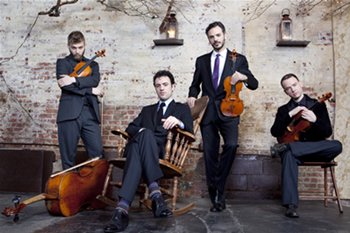Like the old saying that mothers love all their children equally, presenters try to outwardly portray the same level of enthusiasm and admiration for all of their bookings. However, when Emil Kang, Executive Director for the Arts at UNC-Chapel Hill, introduced Brooklyn Rider from the stage of Memorial Hall you could tell that he was particularly enthralled with this unique string quartet. Supporting this observation was his announcement that over the next three years Brooklyn Rider would return to the campus several times for extended residencies and concerts.
Frequent collaborators with Yo-Yo Ma’s Silk Road Ensemble, (minus cellist Eric Jacobsen since that group already has a fairly decent cellist) Brooklyn Rider is oftentimes portrayed as the bad boys of string quartets and in local ads the quote from NPR that “This isn’t your grandfather’s string quartet” was used to attract a clientele other than the usual chamber music devotee. So it was somewhat unusual when these four musicians walked out and played Mozart’s String Quartet No. 8 in F, K. 168. For the Kochel geeks among you, one can see that this is an early work – written while Wolfgang could still be considered a wunderkind at the age of 17. Violist Nicolas Cordes, and violinists Johnny Gandelsman and Colin Jacobsen all played standing, while Colin’s brother, cellist Eric Jacobsen, was slouching it in a chair. This was a sterling example of what constitutes being a superior musician. This supposedly “non-mature” work was awakened with brilliant technique, sensitive phrasing and articulation, and subtly shifting tonal qualities. The highlight was the exhilarating final fugal allegro which displayed the audacious chops of all the players and showed that the teenage Mozart had absorbed papa Bach’s teachings.
We now move on to the “bad boys” part of Brooklyn Rider as they played Seven Steps, an original communal composition (gasp! Socialism in Chapel Hill). Composed while they were grappling with Beethoven’s monumental Opus 131 string quartet, this is a wonderfully inventive piece that clearly shows there are still special effects and techniques left to explore on stringed instruments.
Just when you think you’ve heard every type of crossover combination possible, up jumps something like this: Philip Glass marries Brazilian master Joao Gilberto. Colin Jacobsen arranged Gilberto’s Undia, combining the sensual Brazilian with the somewhat mechanical Glass, and, it worked for me. Next was a display of virtuosic gypsy fiddling as the group played a traditional Romanian tune that also had a taste of Klezmer. The first half closed as they invited a guest flutist playing a thin, black instrument whose sound can possibly be described as a piccolo recorder. The creativity of these musicians was amply on display as they combined remarkable virtuosity with telepathic interplay and the ability to produce sounds which had even seasoned string players in the audience asking “How’d they do that?”
Oh, did I mention that there was also a full chamber orchestra at this concert? In a most unusual bit of programming that I don’t recall experiencing before, we had a brand-name string quartet followed by an orchestra. The Knights is a New York based orchestra initially formed as a large group of friends just getting together to play for fun. Brooklyn Rider has been part of this group from the start and cellist Eric Jacobsen serves as their conductor. For the third time in about three months, Memorial Hall was presenting a performance of probably the most well-known symphonic work: Beethoven’s Symphony No. 5. The size of the ensemble was actually slightly larger than your average chamber orchestra, but they played with the flexibility and assurance of a quartet. Having just played this classic – and about to play it again next month – I was most drawn to The Knights’ observance, sometimes excessively so, of the dynamics. The tension created, the releases and the surprises brought about by these extreme ranges were quite exhilarating. While certainly not a HIP (Historically Informed Practice) ensemble, they played with some, but not a great deal of, vibrato and the tempos were brisk and highly articulated. Best of all, they all looked like they were having a great time.











